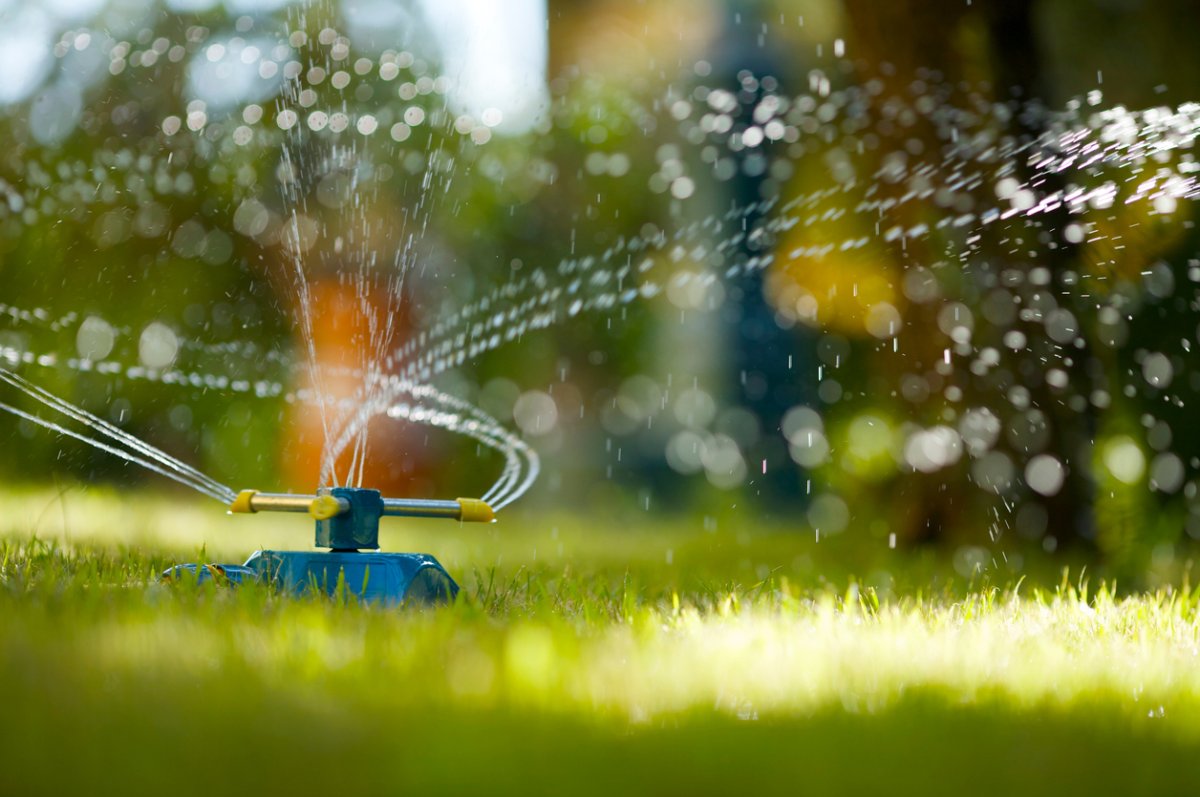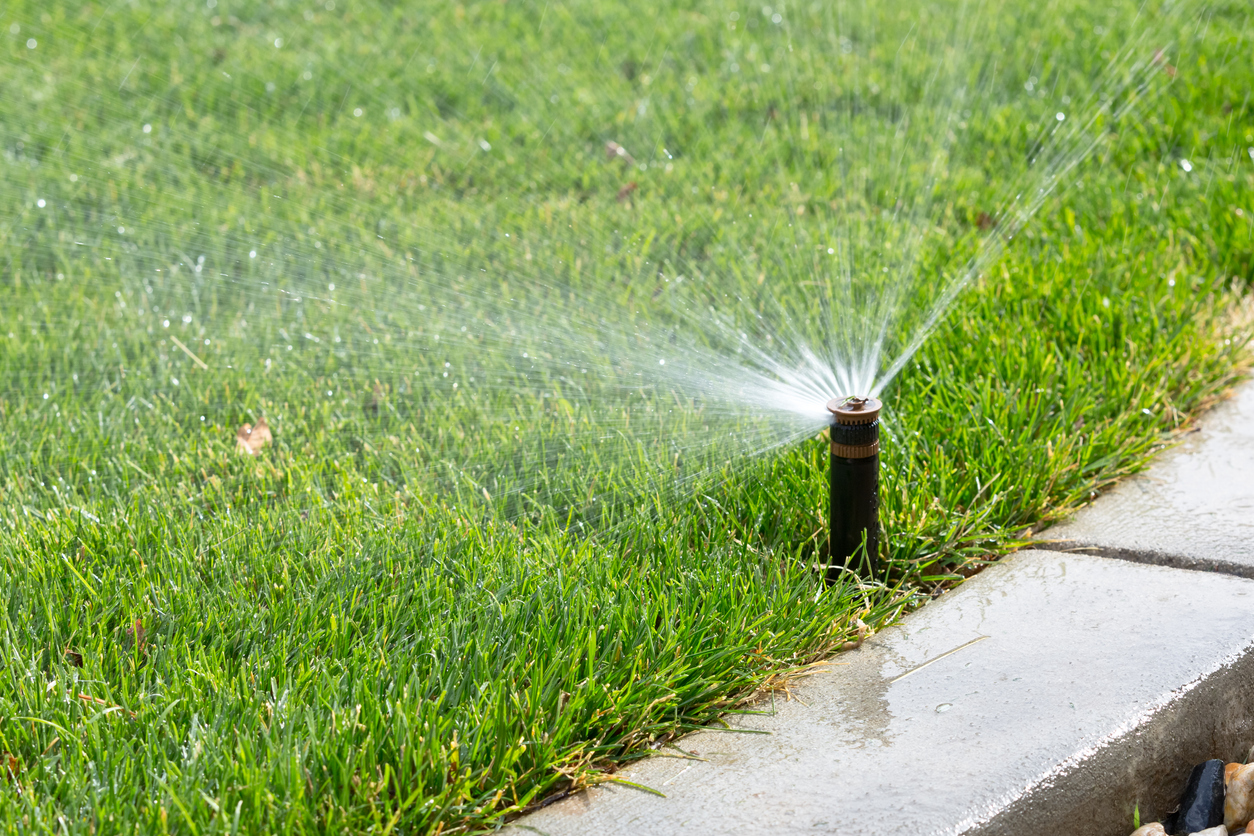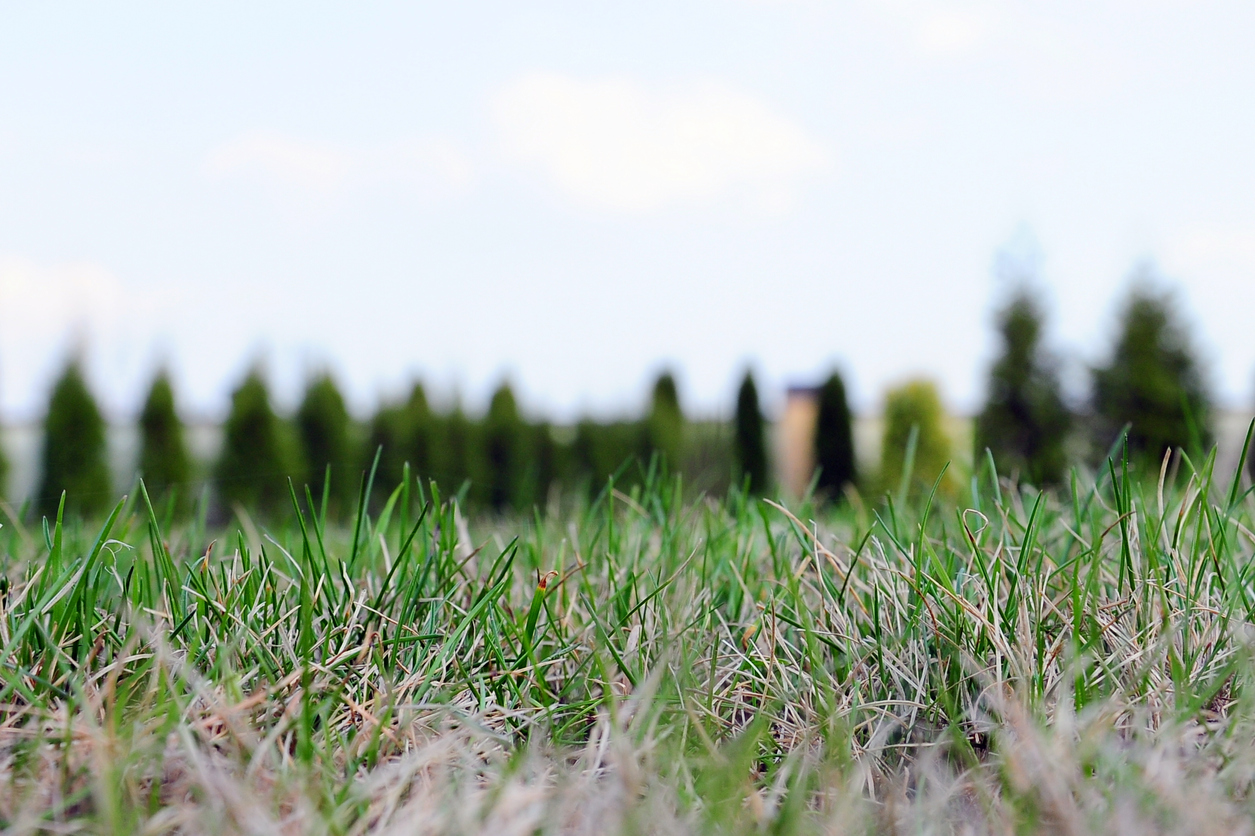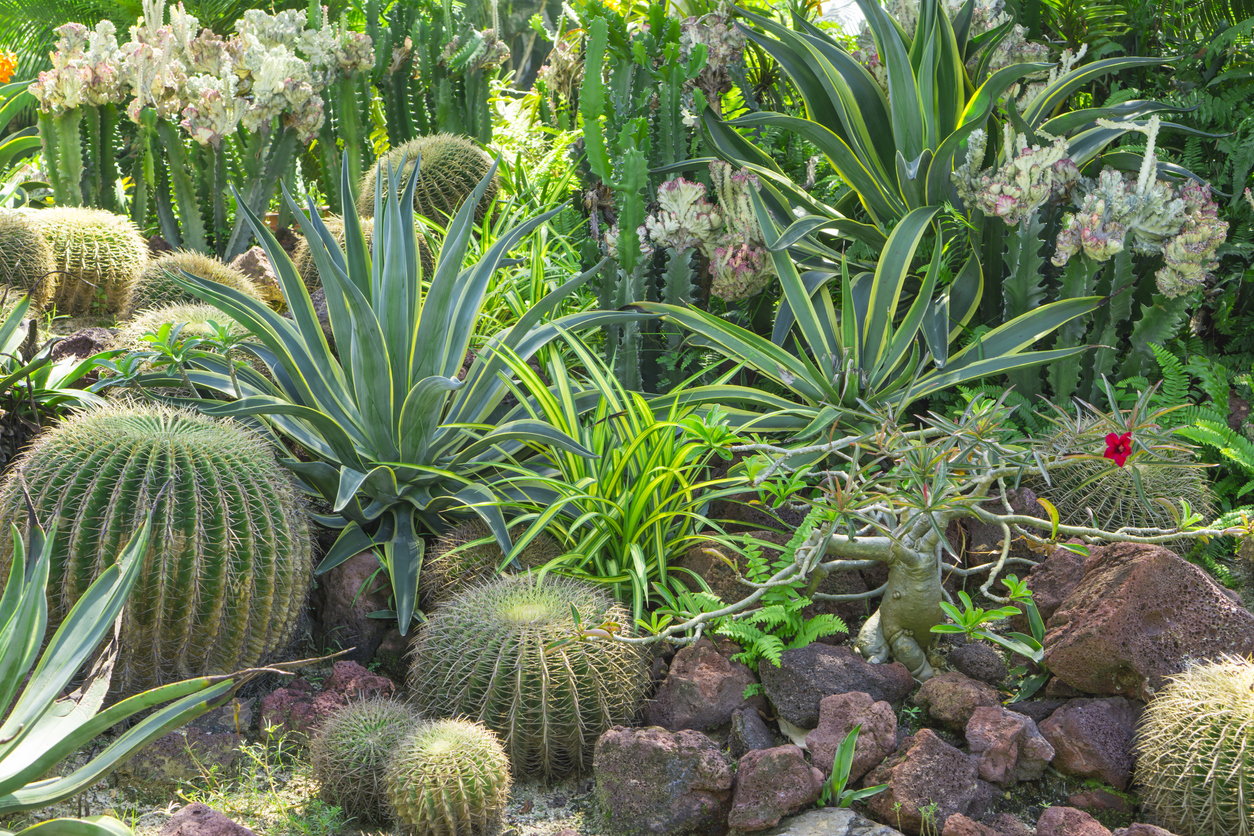

We may earn revenue from the products available on this page and participate in affiliate programs. Learn More ›
Q: I notice neighbors’ sprinklers running at all hours of the day. What’s the best time to water grass, and how much water is enough?
A: When to water your lawn is no longer just a question of how to get the greenest, most pristine grass in the neighborhood (though it remains a factor). With many communities experiencing drought in recent years, it’s more important than ever to heed common-sense guidelines when watering a lawn. Doing so correctly can save resources while keeping you out of hot water with your homeowners association and even your city. In areas where HOAs and municipalities enforce strict rules, wise watering can save you from fines as well.

Early in the morning is the best time to water grass.
Watering grass during the day, preferably at sunrise when everything is cooler, will ensure optimal water absorption. Watering grass at night or later in the day—particularly if it’s bright, warm, and breezy—means that the wind and heat of the sun and soil will rob your grass and other plantings of precious hydration. Water is less likely to evaporate in morning’s lower light and temperature, so you waste less. If you get the job done at dawn, you’re giving the water a greater chance of reaching the roots and being fully utilized. So set those sprinklers accordingly.
Water newly planted grass seed twice daily to help it take root.
Grass seeds require constant moisture and tend to grow best in temperatures ranging from 59 to 69 degrees Fahrenheit. These conditions help them germinate. Depending on the variety of grass seed planted, germination takes 5 to 30 days.
The goal with watering grass seed is to keep the top 1.5 inches of soil moist, but not soggy, all the time. The right amount of water is crucial for helping the sprouts take root. Not enough water dries out the sprout and kills it, whereas too much water can puddle or run and wash away the seed, creating clumps or bare spots. In general, water grass seed twice a day for 5 to 10 minutes, once in the morning and once in the afternoon after the hottest part of the day has passed.

The amount of water you use is also critical.
It might seem smart to set your sprinkler or irrigation system to the highest setting and drench the area as rapidly as possible, but if you water too quickly, you can experience runoff. This robs the lawn of ample absorption and wastes water in the process. So keep an eye on the edge of your lawn to make sure you’re not literally letting precious water run down the drain when it could be helping your grass grow.
Cool-season and warm-season grasses have different watering needs.
Cool-season grasses are often found in cooler, northern climates or planted in the off-season of warmer ones. These grasses start growing when the soil temperature reaches about 40 to 60 degrees Fahrenheit, with peak growing seasons in the spring and fall. When watering a lawn of cool-season grasses, you typically need about 1 inch of water per week. This can be achieved by watering three times each week at regularly spaced intervals.
Warm-season grasses make their home in warm, southern climates. These types of grasses start growing when the soil temperature hits between 60 and 65 degrees Fahrenheit, reaching their peak growing season in the summertime. As a result of their heat tolerance, warm season grasses develop deep roots. When watering a lawn of warm weather grasses, only give them only ½ to 1 inch of water per week. These types of grasses only need to be watered once, maybe twice, each week.

Follow the general rule of one inch of water every week.
More than an inch of water a week can drown your grass, depleting it of oxygen and causing it to die, so measure your output and wait about 3 days between each watering session to give it a chance to breathe. To ensure you’re hitting the mark, place a few coffee mugs around your yard and test the sprinkler system to see how long it takes to fill each cup to the ⅓- or ½-inch mark.
Then, set the system for that same amount of time every 3 days or so. Watering daily is almost always too frequent, while once a week is rarely enough. So aim down the middle and watch your lawn flourish.
Water your mature lawn one to three times per week.
Your lawn-watering schedule depends on whether you have warm-season grasses or cool-season grasses. The extensive root systems of warm-season grasses grow deep into the soil and require less frequent watering. You want to water these grasses as infrequently as possible.
Cool-season grasses, on the other hand, have a shallow root system, and therefore require constant moisture. Watering up to three times each week can help the roots obtain the nutrients they need to grow.

Keep an eye out for dryness.
Grass that’s discolored or curled over at the top is likely suffering from a lack of moisture. The same is true of a lawn that still shows your footprints after you’ve trod a path across it, with the grass blades refusing to bounce back up. If you notice these signs of dryness, adjust your lawn watering schedule to start earlier in the day and allow for slightly longer sessions, or perhaps fine-tune your watering days to occur a bit more frequently.
Watch out for overwatering, too.
If the ground feels particularly sponge-like and your feet sink in as you walk across it, or if you see a thatch of extra vegetation taking hold of your topsoil when you run your hand over the blades, you’re watering a lawn too much. However, when modifying your frequency, don’t do so abruptly. Take a few weeks to slowly adjust your lawn watering schedule to keep the shock of change from further ruining your lawn.
Looking to cut back on water use? Consider xeriscaping or native landscaping.
Xeriscaping involves landscaping that requires no or minimal watering, often using sand, pebbles, mulch, or rock gardens where grass would otherwise be found. Native landscaping involves grasses and plants that thrive naturally with typical local rainfall, reducing or eliminating the need for extra watering. You also can check with local sources to find grasses native to your area and grow a small patch for kids and dogs to enjoy.
Both xeriscaping and native plants are attractive and effective ways to cut back on your water bill, and some homeowners choose to combine the two for a beautiful, eco-friendly landscape that demands little upkeep. Plus, you don’t have to worry about the best time to water grass in summer heat or winter conditions; instead, you’ll have a landscape well suited to the elements in your region year-round. Whichever approach you choose, best of luck with your outdoor space!

Final Thoughts
The best time to water grass is in the early morning, which gives the water time to absorb before midday heat, and helps deliver the nutrients and oxygen the grass needs to thrive. Do the research to find out more about your lawn and the type of grass you have to provide the care it requires. Understanding the needs of your grass or grass seeds will help you determine how much water you need.
Be sure to water thoughtfully, which better manages your water resources, and helps your lawn grow. Take care to avoid overwatering, which can push essential nutrients out of reach of the roots, along with underwatering, which can create dried-out patches on your lawn.
With the right amount of water delivered at the best time of day, your lawn is sure to see an improvement.

FAQs
A common misconception about watering grass in the sun is that the water droplets act like a magnifying glass, burning the grass beneath it. Dry spots on your lawn form when they receive insufficient water. Watering in the heat of the day causes the water to evaporate faster, so your lawn isn’t getting as much moisture as you think it is, which is why the best time to water grass is early in the morning.
You should only water your grass after mowing if you notice that your grass is in dire need of moisture. If your mowing schedule coincides with your early morning watering schedule, by all means, water your grass after mowing. For those who prefer to mow their lawn during the day, wait to water the grass until the next morning.
Grass seed needs to be watered at least twice a day to help the seeds germinate. This process takes 5 to 30 days depending on the variety of grass, so follow the grass supplier’s instructions. The goal is to keep the top of the soil consistently moist to help the seeds germinate and sprout into grass.
The depth of grass roots depends on the variety of grass you are using. Many grass roots are found close to the surface, as little as a few inches deep. With mature lawns that have time to grow and establish themselves, grass roots can be as deep as 3 feet.
The best time to water grass seed is in the early morning and in the afternoon after the hottest part of the day has passed. In warmer or drier climates, you may have to water more often. Grass seed requires constant moisture in the top 1½ inches of soil to help the seed germinate.
